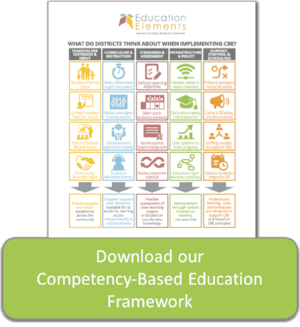
by: leighann gunn and brittany griffin on march 22nd, 2017
creating a culture of relearning in your cbe classroom
competency-based education | classrooms
the biggest frustration i hear from teachers who are implementing competency-based education (cbe, also known as mastery-based education or learning) is that students' motivation drops considerably when they realize they can retake tests until they get a passing score. it seems, much to the chagrin of the teachers, some students no longer take assessments seriously. how do you ensure your transition to a competency-based classroom results in an emphasis on learning and re-learning rather than testing and retesting?
a classroom paradigm shift has to take place. in a competency-based classroom where students only proceed upon mastery of content, the pattern 'learn, test, remediate' can no longer be the norm. such a pattern is incredibly teacher-centric, as students often don't know what they don't know until the test. additionally, the onus for remediation (and tracking the student down to retest) rests on the shoulders of the teacher. ideally, students would feel responsible for their own re-learning and test when they’ve mastered the content.
instead, the pattern should be 'learn, formative check, remediate (repeat), and then test/demonstrate mastery.' the teacher holds the keys to the summative assessment; students have to prove their readiness before they attempt to demonstrate mastery. the students are responsible for learning and relearning as needed and re-learning precedes, not follows, a test. students in a cbe environment should rarely have to retake tests. rather, students should not attempt an assessment until both the student & teacher are sure the content and/or skills have been mastered.
here are five key steps to build a culture of re-learning in your own competency-based classroom:
- 1. identify an upcoming standard/competency. don’t try to recreate your entire curriculum. instead, start with one learning objective, standard, or competency that you plan to teach and assess in the next two weeks.
- 2. create a short checklist of skills and knowledge needed to succeed on the assessment. what do students need to know in order to do well? everyone loves a good checklist, and the items will serve as the categories students must master before attempting the summative assessment. (example 1, example 2)
- 3. for each checklist item, create formative assessments to measure mastery. how will students know what they know and don’t know? try digital tools for formative assessment of specific concepts or skills. the advantage to this approach: it lowers teachers' workload regardless of student repetition. no need to grade multiple attempts at an activity or even run copies of worksheets - the software automatically scores & provides feedback. once you’ve built your formative assessments, it’s a good time to review your summative one. do these formative checks accurately measure mastery of all the skills and concepts you will test at the end?
- 4. align content and practice activities to your standard/competency checklist. here you might vary the types of activities depending on the difficulty of the content and readiness level of students. for example, a teacher-led mini-lecture might be necessary to establish background knowledge before students pair up for collaboration and processing to make sense of new ideas. in addition, the source of content for activities might vary, with textbooks, oer artifacts or lessons, or lab/simulations serving as a foundation for building knowledge. (example)
- 5. build structures for students to track and reflect on their checklist progress. the sum of mastering all formative checks should equal success on the summative assessment. how will students track their progress and know when they’re ready to attempt the summative? (example 1, example 2, example 3)
planning for a competency-based classroom can be intimidating. however, once students take ownership of their progress, teachers are able to connect with students in meaningful, targeted ways through small-groups and 1:1 instruction. these relationships are critical for avoiding ‘content churn,’ where students spend too much time memorizing content for a single test. cbe teachers can fall into a checklist mentality of covering content and demonstrating mastery such that they lose sight of the big picture.
even as you shift to formative assessments, be sure you’re always helping students make meaning of the material in reference to their own interests, goals, or aspirations. help your students see how each daily piece fits into a larger conceptual whole.
- brittany griffin is a design principal at 瑞士vs喀麦隆亚盘赔率
who lives in atlanta, ga with her family.
- leighann gunn is a competency-based high school social studies teacher at piedmont high school in al.


